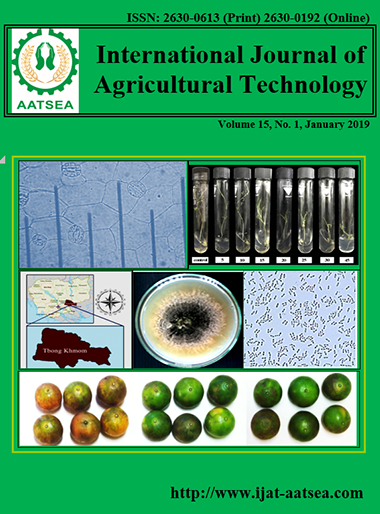Sustainability assessment from development indicators of community and sustainable development guidelines for the Huay Pao highland development project using royal project system
Main Article Content
Abstract
The community sustainability was investigated by developing sustainability indicators and Sustainable Development Guidelines for the Huay Pao Highland Development Project Using Royal Project System, Thungkhaopuang sub-district, Chiang Dao district, Chiangmai province. The selection of areas by experts of Highland Research and Development Institute (Public Organization). The population of this study was 50 persons. Data were recorded between October to December 2017 by focus group discussion and the structure interview. The focus group discussion could synthesis of sustainability indicators with community. It can be divided into 4 factors, total 32 indicators including 10 indicators of economic factor, 8 indicators of social factor, 7 indicators of environment factor and 7 indicators of infrastructure factor. The results of the community sustainability assessment from the developing sustainable indicators found that a community of the Huay Pao highland development project using Royal Project system had a strong focus on 4 factors. The overall sustainability assessment of the community was a very good level. Except for the environment factor was a good sustainable of the community. However, this community of the Huay Pao highland development project using Royal Project system is accelerated by the development of the economy factor for saving, knowledge in career development, and food security. Social factor was the strengthed development of leaders and peoples in the community, and promoted the establishment of farmers' institutions. Environment factor was promoted the soil and water conservation, increasing forest area, the community forest, and protection the external threats. Infrastructure factor was development of electricity services in the area, improve the services of the District Health Promotion Hospital, and developed the remote communities that provided to access both formal and informal systems. It is suggested to develop community should concern the needs of the community into consideration. Also, in the development of the highland community, it is important to focus on working in integrated with relevant agencies.
Article Details

This work is licensed under a Creative Commons Attribution-NonCommercial-NoDerivatives 4.0 International License.
References
Bhandari, B. S. and Grant, M. (2007). Analysis of livelihood security: A case study in the Kali-Khola watershed of Nepal. Journal of Environmental Management. 85:17-26.
Chaiwinit, W. (2009). Economically and environmentally optimal highland crop production plans at farm level, Mae Suk watershed, Mae Chaem district, Chiang Mai province. (Master Thesis). Chiangmai University, Thailand.
Chiangmai University (2008). Complete report of highly developed database and information development. Highland Research and Development Institute (Public Organization).
DLD (1998). Framework of evaluation of sustainable land management, A case study Ban Pha Duea, Mae Fha Louang. Department of Land Development.
Ekasingh, B. and Promburom, P. (2010). Complete report on development indicators for economic, social, resource and environmental development in highland areas. Highland Research and Development Institute (Public Organization).
Ekasingh, B., Ekasingh, M. and Promburom, T. (2001). Indicators of sustainable land resource use in highland agricultural systems. Journal of Agriculture. 19:7-85.
Felix, M. and Judith, M. (2010). A farm resource allocation problem: Case study of small scale commercial farmers in Zimbabwe. Journal of Sustainable Development in Africa. 12:315-320.
Highland Research and Development Institute (Public Organization) (2017). Master plan project expansion project Royal Project 2017-2021. Chiang Mai: Wanida Printing.
Institute for Sustainable Communities (2015). Definition of sustainable community. Retrieved from the http://www.iscvt.org/impact/definition-sustainable-community.
Noppakunwong, R. (2007). The project gathers knowledge about the conditions for success and good performance of the Royal Project for the development of integrated highland areas. Highland Research and Development Institute (Public Organization).
Office of the National Economic and Social Development Board (2010). Report on the strategic plan for the development and conservation of natural resources in the Northern highlands. Highland Research and Development Institute (Public Organization).
Praneetvatakul, S. and Sirijinda, A. (2005). production plan for sustainability of highland agricultural systems in Northern Thailand. Journal of NRCT. 39:93-107.
Praneetvatakul, S., Janekarnkij, P., Potchanasin, C. and Prayoonwong, K. (2001). Assessing the sustainability of agriculture: A case of Mae Chaem Cathchment, Northern Thailand, Environment International. 27:1-7.
Promburom, P., Limnirankul, B., Thong-ngam, K. and Kaewmuangmoon, T. (2013). Full report of community development process, and community happiness indicators in the highlands. Highland Research and Development Institute (Public Organization).
Thammajinda, R., Chingchayanurak, C., Jitaree, W., Trakarnsirinont, W. and Na Ayudhya, T. N. (2017). The development of a sustainable community enterprise model: A case study of the Puk Plod San Ban Don Satan group in Pua district, Nan province. Journal of Community Development Research (Humanities and Social Sciences). 10:98-107.


